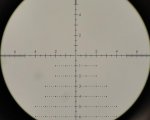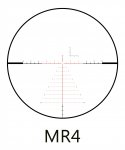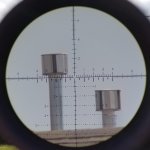I'm a long time fullbore, high power and now F-class shooter. I only ever use MOA (I actually dream in MOA,) and even though I "understand" mil, I don't use it. I hold off on the target using the rings, so I like a fairly uncluttered reticle. So enlighten me, what would I look for in a mil reticle for PRS?
Again, it would boil down to personal preference. For me, and I will use the above posted picture of the FML-T1 as an example...
Overall good layout on the reticle, but get that cluster of big lines out of the center of the reticle. Have the main horizontal and vertical lines continue to the center, and have them intersect with a hollow square hole in the center, just like the Leupold TMR reticle does. No floating dot.
I prefer the main lines to be 0.05-Mil thick, but no less than 0.04-Mil. some people would still complain about that being too thick, but realistically, even at a 1000-yards, you're not obscuring the target, unless your trying to shoot at a 1" dot, again, not realistic. You need the thickness to be adaptable for field conditions; low light, dark background, heavy mirage, aging eye's, low magnification, etc.
I use the MSR reticle in a S&B 5-25 on most of my rifles. Use it on my ELR rigs, shooting out beyond 2000-yards, and it never obscures the targets, and the line thickness on the MSR is 0.05-Mil.
I like the 0.2-Mil hash marks on the FML-T1. Very simple, uncluttered format, and easy to see (unlike the Burris SCR, which is harder to see). March could go as far as using a tapered reticle (Like the FML-1), starting out at let's say 0.06, and tapering down to 0.03 in the center.
As far as the Christmas Tree part of the reticle, I like how it is uncluttered, and easy to see through so to speak, but until I see it at 30x magnification, I'll reserve further comments on that part.
Last edited:







